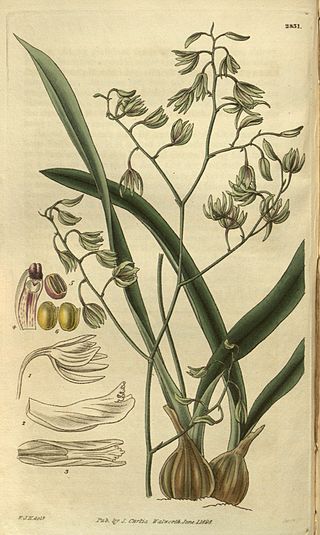
Brassavola is a genus of 21 orchids. They were named in 1813 by the Scottish botanist Robert Brown. The name comes from the Italian nobleman and physician Antonio Musa Brassavola. This genus is abbreviated B. in trade journals.

Cattleya is a genus of orchids from Costa Rica south to Argentina. The genus is abbreviated C in trade journals.

Epidendrum, abbreviated Epi in the horticultural trade, is a large neotropical genus of the orchid family. With more than 1,500 species, some authors describe it as a mega-genus. The genus name refers to its epiphytic growth habit.

Encyclia is a genus of orchids. The genus name comes from Greek enkykleomai, referring to the lateral lobes of the lip which encircle the column. It is abbreviated as E. in the horticultural trade.

Dinema is a genus of orchids. It is represented by a single currently accepted species, Dinema polybulbon, native to Mexico, Central America, and the Caribbean.

Prosthechea is a genus of flowering plants in the orchid family (Orchidaceae). The name is derived from the Greek word prostheke (appendix), referring to the appendage on the back of the column. Appendage orchid is a common name for this genus. Prosthechea is abbreviated Psh. in the horticultural trade.

Oncidium alexandrae, synonyms including Odontoglossum crispum, is an epiphytic orchid in the genus Oncidium. Known as the curled odontoglossum, it is considered by many to be the most beautiful orchid of all but is also one of the most difficult to grow.

Cattleya maxima is a species of orchid in subfamily Epidendroideae found from Ecuador to Peru.

Isabelia is an orchid genus formed by three tiny species and one natural hybrid, spread from the Northeast of Brazil to Argentina, which are closely related to the genus Constantia. During more than a century Isabelia was a genus formed by just one species, however, around 1968, it was merged with genus Neolauchea, also unispecific. In 2001, a third genus was added to it, Sophronitella. The genus name is abbreviated Isa. in cultivation.

Loefgrenianthus blanche-amesiae is a showy orchid species, inhabitant of Serra do Mar mountains in Brazilian southeast. It is the only species of the monotypic genus Loefgrenianthus. It can be differentiated from its closest genus, Leptotes, both because of its pending vegetation with flat leaves and the flowers which have a saccate labellum. Loefgrenianthus blanche-amesiae is highly appreciated by orchid collectors.
Bulbophyllum lageniforme, commonly known as the smooth strand orchid, is a species of epiphytic or lithophytic orchid that is endemic to tropical North Queensland. It has flattened, pale green, grooved, clump-forming pseudobulbs, stiff, dark green leaves and up to four cream-coloured or pale green flowers with a pink labellum. It usually grows on shrubs, trees and rocks in highland rainforest.
Bulbophyllum macphersonii, commonly known as eyelash orchids, is a species of epiphytic or lithophytic orchid that is endemic to Queensland. It has tiny, crowded, slightly flattened, dark green pseudobulbs, a single thick, fleshy leaf and a single dark red to purplish red flower with a narrow labellum. It grows on trees and rocks in sheltered places.
Encyclia fehlingii is a species of orchid that was named for Gladys Fehling who lived on Andros Island in the Bahamas and spent much of her time searching for the orchids of the area and growing them for her own pleasure. The plants of Encyclia fehlingii are epiphytic and grew mostly in the Fresh Creek area on Andros, but the species has also been found on New Providence Island and on Abaco.

Cattleya rex is a species of epiphytic orchid of showy white flowers, native to montane forests in Peru and Bolivia.

Dendrobium moorei, commonly known as the drooping cane orchid, is a species of epiphytic or lithophytic orchid in the family Orchidaceae and is endemic to Lord Howe Island. It has cylindrical pseudobulbs, leathery, dark green leaves and between two and fifteen small, white drooping flowers that do not open widely.

Prosthechea citrina, synonym Encyclia citrina, is a species of orchid native to southwest Mexico. It is known as tulip orchid and has a strong lemon fragrance. Its petals are golden yellow with varying degrees of white crenulations in the lip. The plant may be upright or pendant, but the flowers are always pendant. It is also known as the tulip orchid due to its flowers' rounded cup-like shape. It has been referred to for generations as costicoatzontecoxòchitl, meaning "flower in the form of yellow serpent head", by the Nahuas.

Cattleya iricolor is a species of orchid native to the eastern montane forests of Ecuador and Peru.

Encyclia candollei is a species of epiphytic orchid of yellow-brown to reddish flowers, native to Belize, Guatemala and Mexico.

Encyclia viridiflora is a species of epiphytic orchid of green flowers, native to the north of Brazil and is the type species for the genus Encyclia. Especially the specimen was found in the area of Rio de Janeiro.

Encyclia advena is a species of epiphytic orchid, native to Atlantic forests in Brazil.





















